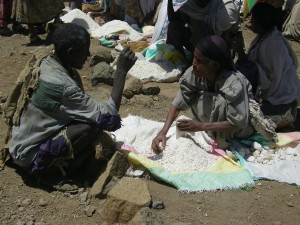6 March. Sadly, Jeff left us today to return via Addis and Germany to Vancouver. It is the weekend, and Marlene and I will take two days break given that the universities are closed and we do not wish to impose on our colleagues during their days off.
We elected to fly to Lalibela to see the rock-hewn churches for which this city is famous. The airports in the north are small and not busy. Empty air strips are backdropped by arid, stepped mountains somewhat reminiscent of the US southwest in the Four Corners and Grand Canyon areas. Ethiopia is high plateau, and in the north the cities are typically situated at over 2400 meters. Some visitors remark that they are affected by the altitude even as they negotiate short distances in the slightly undulating terrain within the towns. Locals of all ages, meantime, carry heavy loads of coal, wood, grain, water, etc, to and from market, often from their residences high in the mountains. Here walking is the primary mode of transportation. Those wealthy enough to own a donkey or few to assist with load bearing are lucky.

In the late morning we traversed the market, observing bartering over grains, coffee, honey, livestock, etc. USA foreign aid canisters were frequent means of measurement, although often measurement takes the simple form of estimating the weight of product in one’s palm.
There are 11 medieval monolithic rock-hewn churches dating to the 13th century in Lalibela. We toured approximately half of these, which you may read about here, today. These are still active churches, and so in the first we were welcomed to observe part of a service–a remarkable event.